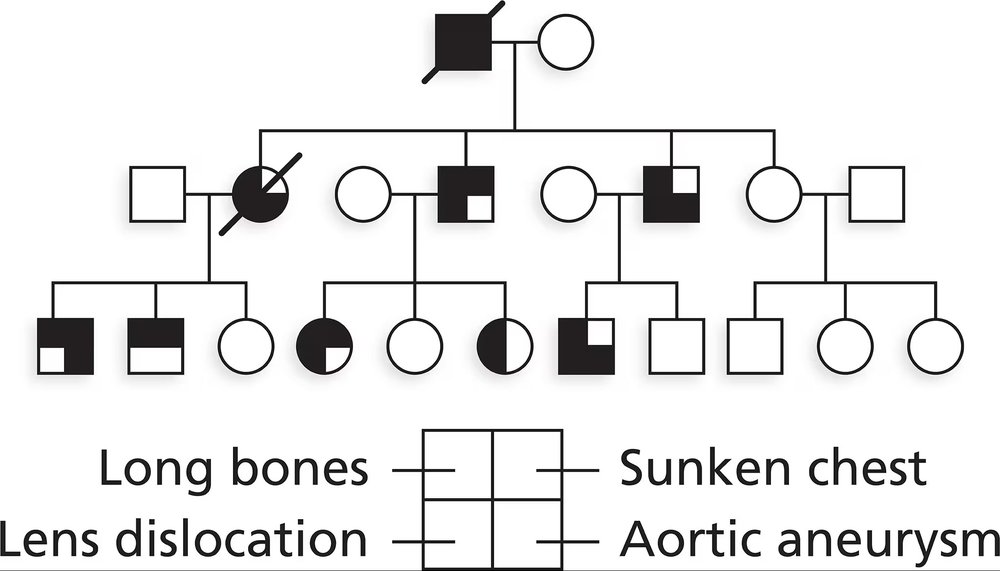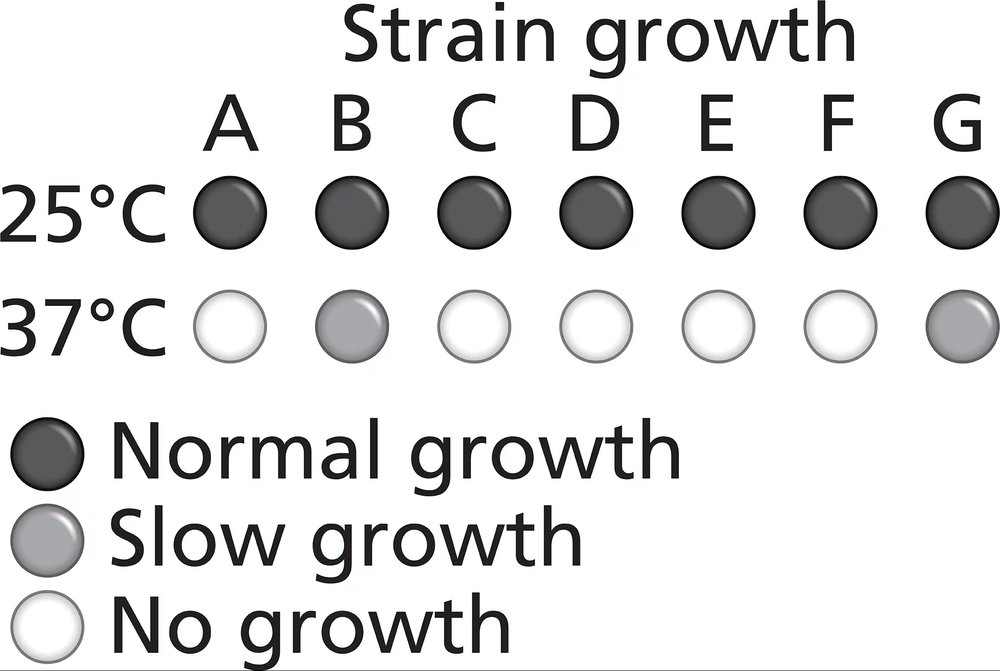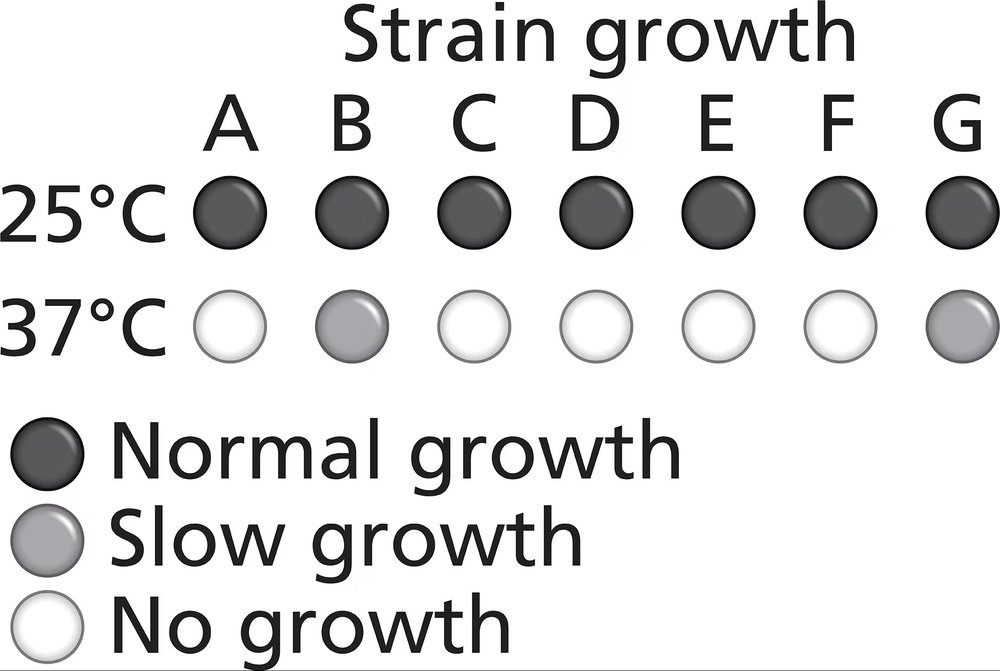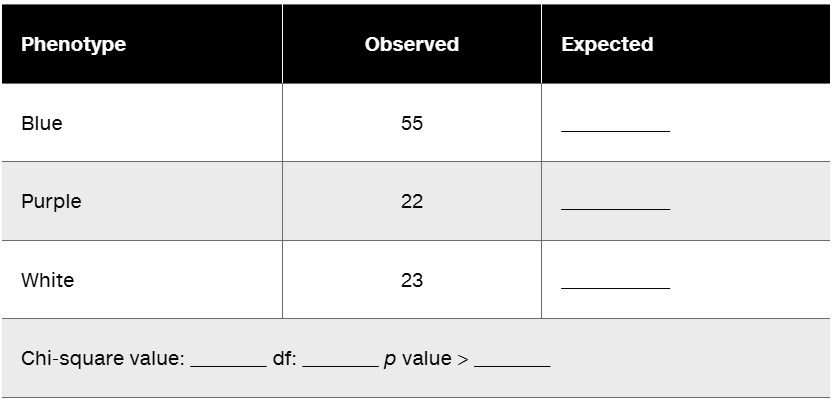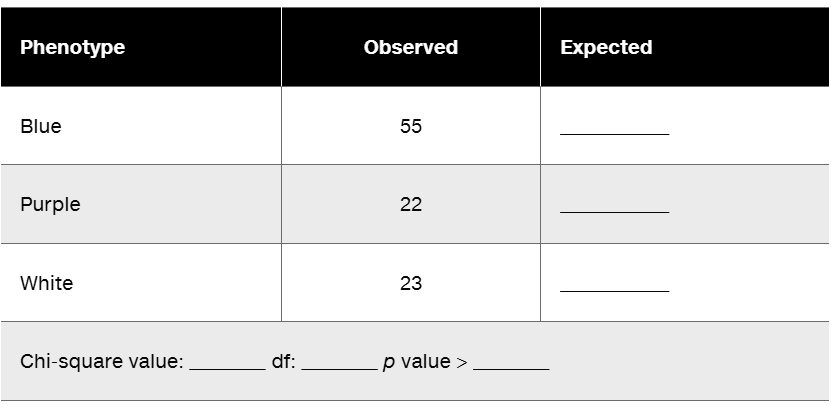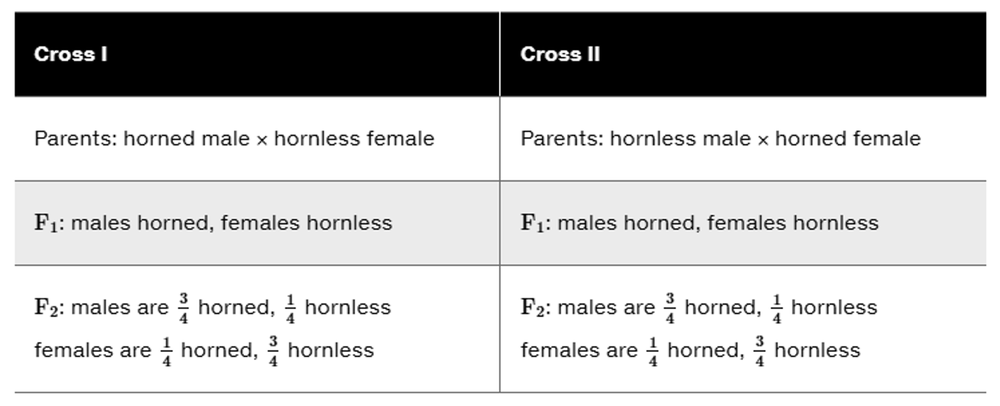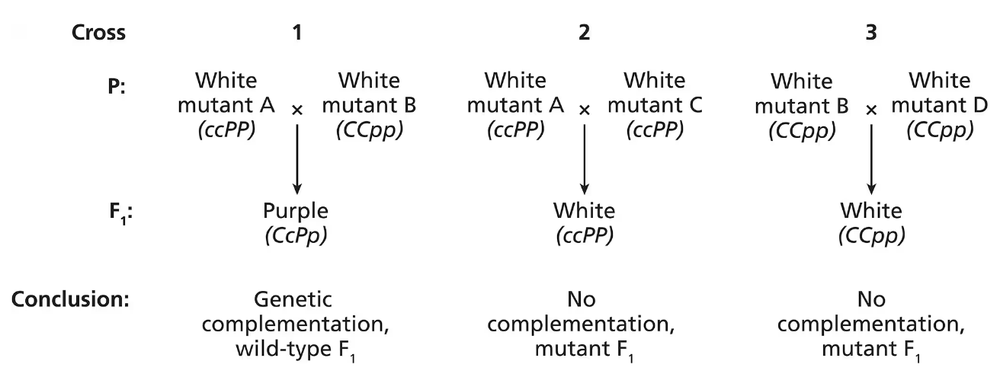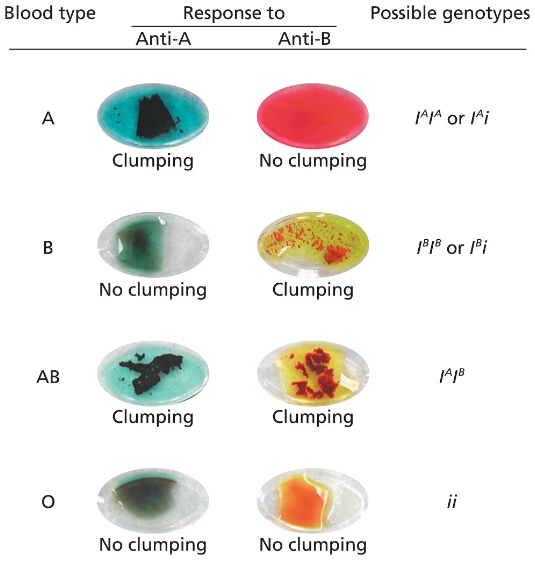 Back
BackProblem 23f
Three strains of green-seeded lentil plants appear to have the same phenotype. The strains are designated G₁, G₂, and G₃. Each green-seeded strain is crossed to a pure-breeding yellow-seeded strain designated Y. The F₁ of each cross are yellow; however, self-fertilization of F₁ plants produces F₂ with different proportions of yellow- and green-seeded plants as shown below.

If strains G₂ and G₃ are crossed, what will be the phenotype of the F₁?
Problem 23g
Three strains of green-seeded lentil plants appear to have the same phenotype. The strains are designated G₁, G₂, and G₃. Each green-seeded strain is crossed to a pure-breeding yellow-seeded strain designated Y. The F₁ of each cross are yellow; however, self-fertilization of F₁ plants produces F₂ with different proportions of yellow- and green-seeded plants as shown below.

What proportion of the F₂ will have yellow seeds? Show your work.
Problem 24a
Blue flower color is produced in a species of morning glories when dominant alleles are present at two gene loci, A and B. (Plants with the genotype have blue flowers.) Purple flowers result when a dominant allele is present at only one of the two gene loci, A or B. (Plants with the genotypes and are purple.) Flowers are red when the plant is homozygous recessive for each gene (i.e., aabb).
Two pure-breeding purple strains are crossed, and all the F₁ plants have blue flowers. What are the genotypes of the parental plants?
Problem 24b
Blue flower color is produced in a species of morning glories when dominant alleles are present at two gene loci, A and B. (Plants with the genotype have blue flowers.) Purple flowers result when a dominant allele is present at only one of the two gene loci, A or B. (Plants with the genotypes and are purple.) Flowers are red when the plant is homozygous recessive for each gene (i.e., aabb).
If two F₁ plants are crossed, what are the expected phenotypes and frequencies in the F₂?
Problem 24c
Blue flower color is produced in a species of morning glories when dominant alleles are present at two gene loci, A and B. (Plants with the genotype have blue flowers.) Purple flowers result when a dominant allele is present at only one of the two gene loci, A or B. (Plants with the genotypes and are purple.) Flowers are red when the plant is homozygous recessive for each gene (i.e., aabb).
If an F₁ plant is backcrossed to one of the pure-breeding parental plants, what is the expected ratio of phenotypes among progeny? Why is the phenotype ratio the same regardless of which parental strain is selected for the backcross?
Problem 25
The crosses shown are performed between morning glories whose flower color is determined as described in Problem 24. Use the segregation data to determine the genotype of each parental plant.

Problem 26a
Two pure-breeding strains of summer squash producing yellow fruit, Y₁ and Y₂, are each crossed to a pure-breeding strain of summer squash producing green fruit, G₁, and to one another. The following results are obtained:

Examine the results of each cross and predict how many genes are responsible for fruit-color determination in summer squash. Justify your answer.
Problem 26b
Two pure-breeding strains of summer squash producing yellow fruit, Y₁ and Y₂, are each crossed to a pure-breeding strain of summer squash producing green fruit, G₁, and to one another. The following results are obtained:

Using clearly defined symbols of your choice, give the genotypes of parental, F₁, and F₂ plants in each cross.
Problem 26c
Two pure-breeding strains of summer squash producing yellow fruit, Y₁ and Y₂, are each crossed to a pure-breeding strain of summer squash producing green fruit, G₁, and to one another. The following results are obtained:

If the F₁ of Crosses I and II are mated, predict the phenotype ratio of the progeny.
Problem 27
Marfan syndrome is an autosomal dominant disorder in humans. It results from mutation of a gene on chromosome 15 that produces the connective tissue protein fibrillin. In its wild-type form, fibrillin gives connective tissues, such as cartilage, elasticity. When mutated, however, fibrillin is rigid and produces a range of phenotypic complications, including excessive growth of the long bones of the leg and arm, sunken chest, dislocation of the lens of the eye, and susceptibility to aortic aneurysm, which can lead to sudden death in some cases. Different sets of symptoms are seen among various family members, as shown in the pedigree below. Each quadrant of the circles and squares represents a different symptom, as the key indicates.
All cases of Marfan syndrome are caused by mutation of the fibrillin gene, and all family members with Marfan syndrome carry the same mutant allele. What do the differences shown in the phenotypes of family members say about the expression of the mutant allele?
Problem 28a
Yeast are single-celled eukaryotic organisms that grow in culture as either haploids or diploids. Diploid yeast are generated when two haploid strains fuse together. Seven haploid mutant strains of yeast exhibit similar normal growth habit at 25°C, but at 37°C, they show different growth capabilities. The table below displays the growth pattern.
Hypothesize about the nature of the mutation affecting each of these mutant yeast strains, including why strains B and G display different growth habit at 37°C than the other strains.
Problem 28b
Yeast are single-celled eukaryotic organisms that grow in culture as either haploids or diploids. Diploid yeast are generated when two haploid strains fuse together. Seven haploid mutant strains of yeast exhibit similar normal growth habit at 25°C, but at 37°C, they show different growth capabilities. The table below displays the growth pattern.
Researchers induce fusion in pairs of haploid yeast strains (all possible combinations), and the resulting diploids are tested for their ability to grow at 37°C. The results of the growth experiment are shown below. How many different genes are mutated among these seven yeast strains? Identify the strains that represent each gene mutation.
Problem 30a
Dr. Ara B. Dopsis and Dr. C. Ellie Gans are performing genetic crosses on daisy plants. They self-fertilize a blue-flowered daisy and grow 100 progeny plants that consist of 55 blue-flowered plants, 22 purple-flowered plants, and 23 white-flowered plants. Dr. Dopsis believes this is the result of segregation of two alleles at one locus and that the progeny ratio is 1:2:1. Dr. Gans thinks the progeny phenotypes are the result of two epistatic genes and that the ratio is 9:3:4.
The two scientists ask you to resolve their conflict by performing chi-square analysis on the data for both proposed genetic mechanisms. For each proposed mechanism, fill in the values requested on the form the researchers have provided for your analysis.
Use the form below to calculate chi-square for the 1:2:1 hypothesis of Dr. Sophila.
Problem 30b
Dr. Ara B. Dopsis and Dr. C. Ellie Gans are performing genetic crosses on daisy plants. They self-fertilize a blue-flowered daisy and grow 100 progeny plants that consist of 55 blue-flowered plants, 22 purple-flowered plants, and 23 white-flowered plants. Dr. Dopsis believes this is the result of segregation of two alleles at one locus and that the progeny ratio is 1:2:1. Dr. Gans thinks the progeny phenotypes are the result of two epistatic genes and that the ratio is 9:3:4.
The two scientists ask you to resolve their conflict by performing chi-square analysis on the data for both proposed genetic mechanisms. For each proposed mechanism, fill in the values requested on the form the researchers have provided for your analysis.
Use the form below to calculate chi-square for the 9:3:4 hypothesis of Dr. Gans.
Problem 30c
Dr. Ara B. Dopsis and Dr. C. Ellie Gans are performing genetic crosses on daisy plants. They self-fertilize a blue-flowered daisy and grow 100 progeny plants that consist of 55 blue-flowered plants, 22 purple-flowered plants, and 23 white-flowered plants. Dr. Dopsis believes this is the result of segregation of two alleles at one locus and that the progeny ratio is 1:2:1. Dr. Gans thinks the progeny phenotypes are the result of two epistatic genes and that the ratio is 9:3:4.
The two scientists ask you to resolve their conflict by performing chi-square analysis on the data for both proposed genetic mechanisms. For each proposed mechanism, fill in the values requested on the form the researchers have provided for your analysis.
What is your conclusion regarding these two genetic hypotheses: the 1:2:1 hypothesis and the 9:3:4 hypothesis?
Problem 31
Human ABO blood type is determined by three alleles, two of which (I^A and I^B) produce gene products that modify the H antigen produced by protein activity of an independently assorting H gene. A rare abnormality known as the 'Bombay phenotype' is the result of epistatic interaction between the gene for the ABO blood group and the H gene. Individuals with the Bombay phenotype appear to have blood type O based on the inability of both anti-A antibody and anti-B antibody to detect an antigen. The apparent blood type O in Bombay phenotype is due to the absence of H antigen as a result of homozygous recessive mutations of the H gene. Individuals with the Bombay phenotype have the hh genotype. Use the information above to make predictions about the outcome of the cross shown below.
IᴬIᴮHh×IᴬIᴮHh
Problem 32
In rabbits, albinism is an autosomal recessive condition caused by the absence of the pigment melanin from skin and fur. Pigmentation is a dominant wild-type trait. Three pure-breeding strains of albino rabbits, identified as strains 1, 2, and 3, are crossed to one another. In the table below, F₁ and F₂ progeny are shown for each cross. Based on the available data, propose a genetic explanation for the results. As part of your answer, create genotypes for each albino strain using clearly defined symbols of your own choosing. Use your symbols to diagram each cross, giving the F₁ and F₂ genotypes. <>
Problem 33
Dr. O. Sophila, a close friend of Dr. Ara B. Dopsis, reviews the results Dr. Dopsis obtained in his experiment with iris plants described in Genetic Analysis 4.3. Dr. Sophila thinks the F₂ progeny demonstrate that a single gene with incomplete dominance has produced a 1:2:1 ratio. Dr. Dopsis insists his proposal of recessive epistasis producing a 9:4:3 ratio in the F₂ is correct. To test his proposal, Dr. Dopsis examines the F₂ data under the assumptions of the single-gene incomplete dominance model using chi-square analysis. Calculate and interpret this chi-square value. Can Dr. Dopsis reject the single-gene incomplete dominance model on the basis of this analysis? Explain why or why not.
Problem 34
In a breed of domestic cattle, horns can appear on males and on females. Males and females can also be hornless. The following crosses are performed with parents from pure-breeding lines.
Explain the inheritance of this phenotype in cattle, and assign genotypes to all cattle in each cross.
Problem 35
Cross-1 shown in the following figure illustrates genetic complementation of flower-color mutants. The produced from this cross of two pure-breeding mutant parental plants are dihybrid (CcPp) and have wild-type flower color. If these F₁ are allowed to self-fertilize, what phenotypes are expected in the F₂ , and what are the expected ratios of the phenotypes?
Problem 36
The wild-type allele of a gene has an A–T base pair at a particular location in its sequence, and a mutant allele of the same gene has a G–C base pair at the same location. Otherwise, the sequences of the two alleles are identical. Does this information tell you anything about the dominance relationship of the alleles? Explain why or why not.
Problem 37a
Epistatic gene interaction results in a modification of the F₂ dihybrid ratio.
What is the expected F₂ ratio?
Problem 37b
Epistatic gene interaction results in a modification of the F₂ dihybrid ratio.
What genetic principle is the basis of this expected F₂ ratio?
Problem 37c
Epistatic gene interaction results in a modification of the F₂ dihybrid ratio.
Give two examples of modified F₂ ratios produced by epistatic gene interactions and describe how gene interaction results in the ratios.
Problem 38a
Draw a pedigree containing two parents and four children. Both of the parents have AB blood type. The first child is type A, the second child is type AB, and the third child is type B.
Assign the genotypes to these five people.
Problem 38b
Draw a pedigree containing two parents and four children. Both of the parents have an AB blood type. The first child is type A, the second child is type AB, and the third child is type B.
The fourth child tests as having blood type O, which is not possible given the parental genotypes. Look at the Figure below and read the description of the molecular process that generates ABO blood group antigens. What other mutation could account for this observation?
Problem 38c
Draw a pedigree containing two parents and four children. Both of the parents have AB blood type. The first child is type A, the second child is type AB, and the third child is type B.
What is the name of the genetic phenomenon producing this observation?

